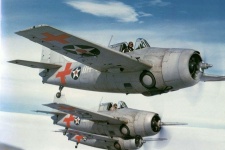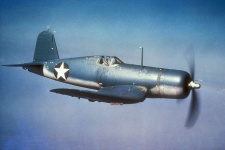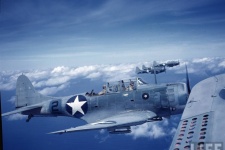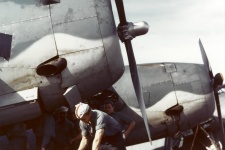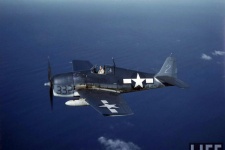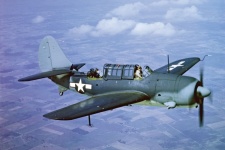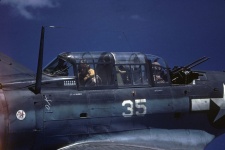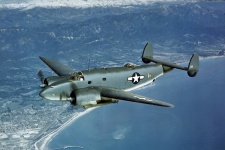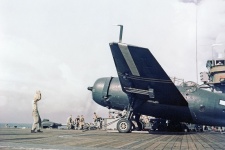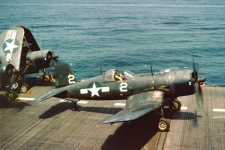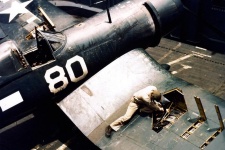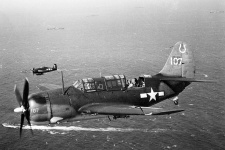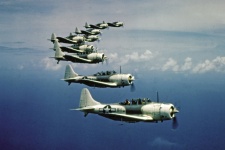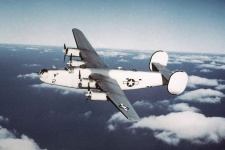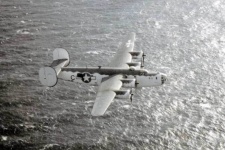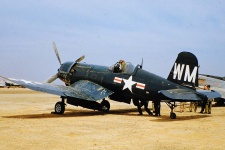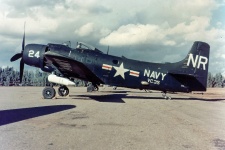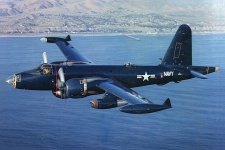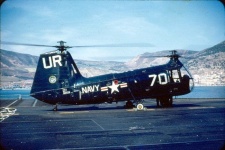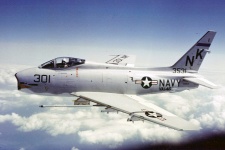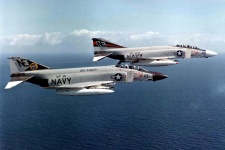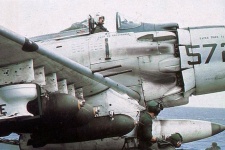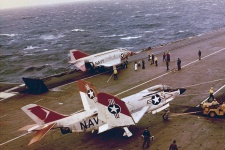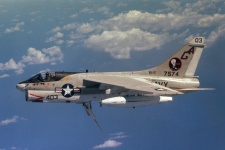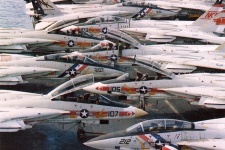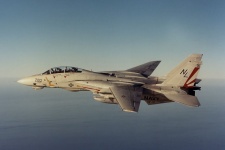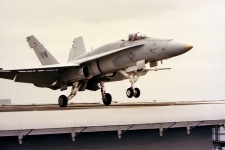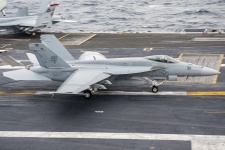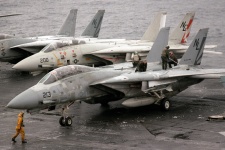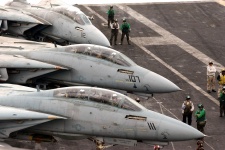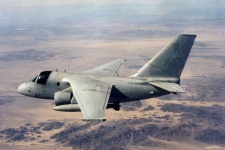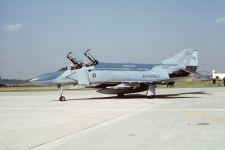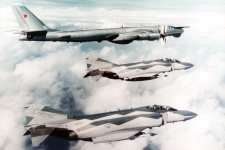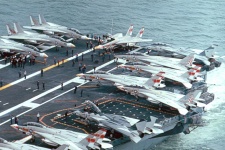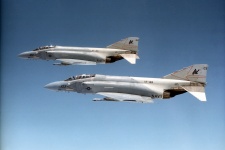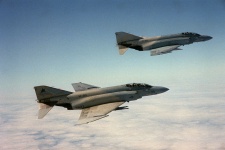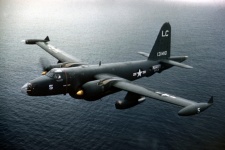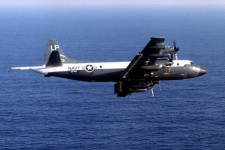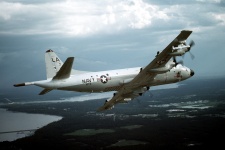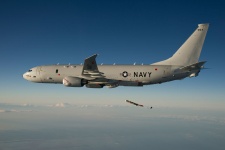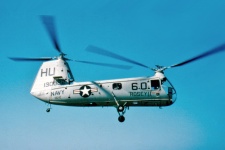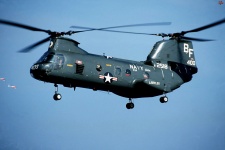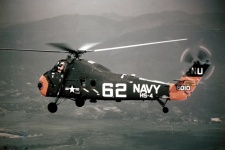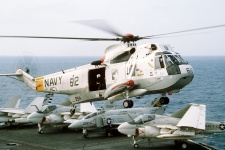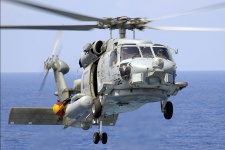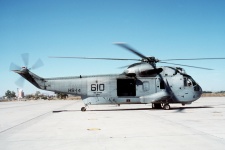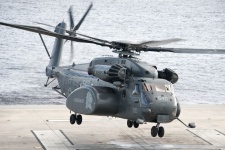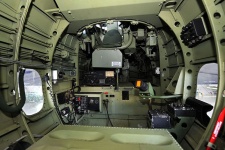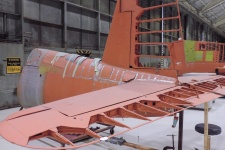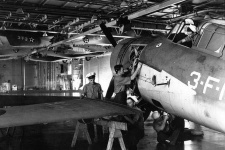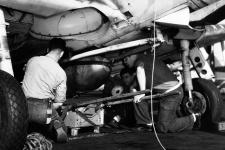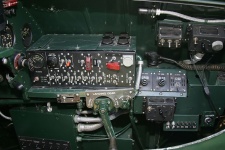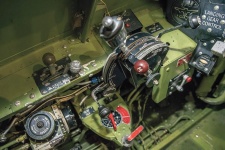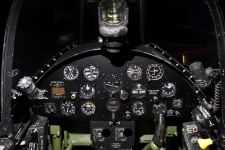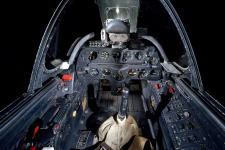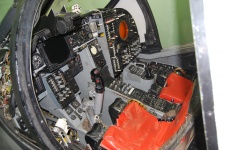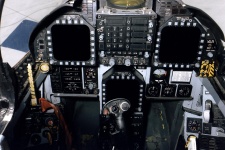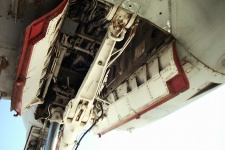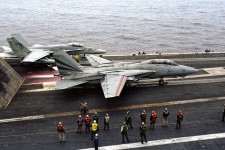Aircraft Colors and Camouflage, US Navy
![]()
Introduction to US color standards
The first color standard in use by the US armed forces was known as Specification No. 3-1, introduced on 28 November 1919 and including a palette of 24 colors of which only one would still be in use during World War II. The earliest standard in use by the US Army Air Corps (USAAC) before the war was Specification 14057 which dated from April 1931 and had been revised numerous times since, the latest being Specification 14057-C on 27 December 1939. An updated eight-color (later nine-color) palette was introduced shortly thereafter, in Air Corps Bulletin No. 41 dated 16 September 1940 and this would include all the main colors in use when the US Army Air Force (USAAF) replaced the USAAC in June 1941. Camouflage schemes would later be specified in the Technical Order No. 07-1-1 although in many cases these were applied in an ad hoc manner by commanders in the field. The US Navy (USN) had its own color system during the early years of World War II based around Bureau of Aeronautics (BuAer) Specification M-485 from 6 December 1940 which listed 6 (later 7) basic non-spectacular (matt) colors.
The need to unify color codes for the USAAF and USN (which used completely different camouflage schemes) resulted in the Army and Navy Aircraft (ANA) system, introduced on 28 September 1943. ANA Bulletin No. 157 included an initial palette of 19 mostly matt (plus a few semi-gloss) colors using a three-digit numbering system in the 600s. ANA Bulletin No. 166 added a further 15 gloss colors numbered in the 500s. A number of additional colors were later added for a total of 44. Notably, a few of these were gloss colors but were added to the 600s range. The ANA system also included numerous substitute colors for British colors, necessary in light of the large number of US aircraft provided to the Royal Air Force and Fleet Air Arm through Lend-Lease.
On 12 January 1950, the US published Federal Specification TT-C-595 which superseded the ANA system with a four-digit numbering system. This was short-lived and just a few years later was superseded by the Federal Standard system, formally known as FED-STD-595. Each color the palette is identified by a five-digit code. The first digit refers to the sheen of the paint, these being gloss (1), semi-gloss (2), and matt (3). The second digit refers to the color, these being brown (1), red (2), yellow (3), green (4), blue (5), gray (6), all others including whites, blacks, and metallics (7), and fluorescents (8). The last three digits are unique for each color and typically go from darker to lighter. The initial palette included 358 colors although some colors only officially exist in one or two out of the three sheens. Although the hues are identical regardless of sheen, there have been some notorious exceptions such as Olive Drab whose semi-gloss version used by the US Army on tanks (FS 24087) was different from the matt version used on helicopters (FS 34087), this being an error that took decades to correct.
The Federal Standard system has gone through numerous revisions, starting with FED-STD-595A in January 1968 (437 colors), FED-STD-595B in January 1994 (611 colors), and FED-STD-595C in January 2008 (650 colors). The ANA Bulletin 157/166 continued to be updated post-war as well, until 15 October 1964 when it was discontinued in favor of FED-STD-595. On February 17th, 2017, the Federal Standard system was replaced by the Aerospace Material Specification Standard 595, or AMS-STD-595. It is largely equivalent to the Federal Standard system and most existing colors have been carried over with identical numbers.
Contents:
- World War II
- Post-War
- Helicopters
- Other
External Links:
- Army-Navy Aeronautical (ANA) Color Comparison w/Equivalents Table
- Urban's Colour Reference Charts, United States
- Federal Specification TT-C-595
- The History of Federal Standard 595
- Federal Standard 595C Range Colour Chart
- AMS Standard 595A Range Colour Chart
- AMS Standard 595 Color
References:
- Doll, Thomas E., US Navy Aircraft Camouflage & Markings 1940-1945, Squadron/Signal Publications (2003)
- Elliot, John M., The Official Monogram US Navy & Marine Corps Aircraft Color Guide Vol 2 1940-1949, Monogram Aviation Publications (1989)
- Elliot, John M., The Official Monogram US Navy & Marine Corps Aircraft Color Guide Vol 3 1950-1959, Monogram Aviation Publications (1989)
- Elliot, John M., The Official Monogram US Navy & Marine Corps Aircraft Color Guide Vol 4 1960-1993, Monogram Aviation Publications (1989)
Paint guide basics:
All colors in this page include a paint chart with matches or equivalences from 19 different model paint ranges. Paints are considered matches if they are labeled with the intended color (either uniquely on together with another color). Paints are considered equivalences if they are close to the intended color but not labeled as such. The accuracy of any paint is independent of whether it is a match or an equivalence and these are described in the text (there can be poor matches and highly accurate equivalences). The following nomenclature is used in the paint tables and is based on matches or equivalences to US Insignia Red FS 11136:
| Paint | Match or equivalence type (label) |
| MP01 | Labeled to match one specific color (FS 11136) |
| MP02* | Labeled to match more than one color of same-country standards (FS 11136 / ANA 509)* |
| MP03** | Labeled to match more than one color of different-country standards (FS 11136 / BS 538) |
| MP04 (!) | Questionable accuracy of label match (doesn't look like FS 11136) |
| MP05 (?) | Questionable accuracy of label match, untested (doesn't look like FS 11136 in the bottle) |
| (MP06) | Close equivalent to FS 11136 (BS 538) |
| (MP07) (?) | Questionable equivalent to FS 11136 (Generic Gloss Red) |
* A single asterisk also denotes implicit matches for same-country standards where there is an official succession between standards. For example, H327* would match ANA 509 even if the label only references FS 11136 since ANA 509 is its official predecessor. This does not apply when there are considerable differences between successive paints (ex: Olive Drab No. 41/ANA 613/FS 34087) and this will be described in the text. By and large, however, single asterisk matches should be considered close enough to unique matches as to not be seriously questioned.
The paint charts make no distinction between gloss, semi-gloss, and matt variants of a color if the correct sheen is unavailable (ex: gloss FS 11136 will be a specific match for matt FS 31136 if the latter does not exist in the same paint range). Exceptions are made where there is a known or suspected color difference (ex: FS 24087 and 34087).
![]()
WORLD WAR II
Early War (1940-42)
On 30 December 1940 the Bureau of Aeronautics (BuAer) determined that the standard color for all ship-based aircraft was to be overall Non-spectacular Light Gray (non-spectacular referring to the matt sheen). This ended a period of experimentation that had taken place earlier in the year, and also the colorful aluminum and yellow scheme which by now was obviously inappropriate for combat conditions. Patrol aircraft would be finished in a two-tone scheme consisting of of a topside color (wings and upper fuselage) of Non-spectacular Blue Gray although the exact color was not initially specified. Later, from 20 August 1941, it was ordered that all ship-based aircraft of the Battle Fleet would use NS Blue Gray topsides and the order was extended to the entire fleet a few months later, on 13 October. Aircraft with folding wings generally had the underside of the folding part painted in the same color as the topside, though this only applied to aircraft where the underside was exposed after folding. So, for example, early Corsairs used Blue Gray on the outer part of the lower wings since they folded upwards. However, the backwards-hinging fold of the Wildcat meant that the entire lower wings were left in Light Gray. As was typical with many USN camo patterns, the colors were sprayed freehand and very inconsistently across units, resulting in some oddities like some Dauntlesses having the tip of their cowls in NS Light Gray.
Neither of the two colors corresponded to a later ANA number and were based on a specification known as M-485 issued on 6 December 1940 (NS Blue Gray was added in 1941 in a revision known as M-485a). This has led to the colors often being referred to as 'Light Gray/Blue Gray M-485'. NS Light Gray is also often designated M-495 but this is incorrect, being based on an unfortunate typo that has been extensively propagated. As to the colors themselves, NS Light Gray is the least complicated of the two since it is a light gull gray that is often compared to ANA 602/620 or FS 36440 although on many photos it appears much lighter. NS Blue Gray is tricker and there is considerable controversy over its exact shade, particularly since the formula was changed in late 1941 and a third version may have been issued in late 1942 as well in preparation for the three-tone scheme (see below) although it is believed it was merely an interim color and not used extensively (if at all). The original Blue Gray faded very heavily in the Pacific sun and had a distinct bleached appearance compared to a freshly painted aircraft. The later version maintained its original color better but was darker and and grayer. An experimental Dark Blue was also known to have been used on some aircraft in a handful of carriers in 1942 in order to better conceal them on deck. Its closest post-war equivalent is FS 35189.
Paint guide:
- NS Light Grey: Few paint ranges have precise matches for these two colors, although Light Gray is so close to FS 36440 that any equivalent is good enough.
- NS Blue Grey: Blue Gray is a trickier color to match as it does not approximate any other color expect FS 35189 and that is questionable. Complicating matters is that no paint range specifies whether the earlier or later versions are being represented. Model Master, Colourcoats, Mr. Paint, and AK Real Color all offer unique matches, though the Colourcoats and AK versions appear much closer to a very faded version of the original and thus far too light for a fresh coat. Matches to FS 35189 are listed in parenthesis unless they make some explicit reference to the wartime color in which case they are listed with an asterisk. Vallejo (71.109) is labeled as Faded PRU Blue and also matched to a BS shade and so accuracy is in question.
Links:
- Grumman F4F and FM Wildcat & Martlet Color Schemes
- Upper camo colour on early war navy planes... (ARC Discussion Forums)
- USN 1941 Light Grey (Britmodeller)
| NS Light Grey | NS Blue Grey (1) | NS Blue Grey (2) | |
| Schemes | |||
| General (Dec 40) | Overall | ||
| General (Aug 41) | Lower | (Upper) | (Upper) |
| Color matches | |||
| Gunze Aqueous | - | - | - |
| Gunze Mr Color | - | C367* | C367* |
| Humbrol | - | - | - |
| Model Master | - | 2055 | 2055 |
| Revell | - | - | - |
| Tamiya | - | - | - |
| Vallejo Model Air | 71.298* | (71.109) (?) | (71.109) (?) |
| Vallejo Model Color | - | (70.904) | (70.904) |
| AKAN | - | - | - |
| AK Interactive | - | - | - |
| AK Real Colors | RC255 | RC256 | RC256 |
| AMMO by Mig | - | - | - |
| Colourcoats | ACUS05 | ACUS06 | ACUS06 |
| Hataka | - | HTK-_218* | HTK-_218* |
| Lifecolor | - | UA 038* | UA 038* |
| Mission Models | - | (MMP-061) | (MMP-061) |
| Mr Paint | MRP-134 | MRP-133 | MRP-133 |
| Xtracolor | - | (X162) | (X162) |
| Xtracrylix | - | - | - |
Mid War (1943-44)
On 5 January 1943 (BuAer Specification SR-2C made effective on 1 February), the US Navy switched to a three-tone camo scheme that became standard of the mid-war period and which was still used for many aircraft right up until V-J Day. The new scheme predated the introduction of the ANA system (28 September 1943) but given that all colors were eventually migrated to the new system, the ANA values are provided for convenience. The objective of the new camouflage was to achieve counter-shading of the aircraft, thus requiring gradually lighter colors from the top down.
Although best known as a three-tone, in reality the new scheme used four different types of paint. Topside colors included Non-spectacular Sea Blue ANA 607 for the fuselage and Semi-gloss Sea Blue ANA 606 for the wings. The reason that a semi-gloss paint was used for the wings was in order to replicate the natural shine of the ocean. Both colors were very similar, and on most color photographs of the time appear nearly indistinguishable although there was a very slight difference in hue between the two despite being notionally different only in sheen (ANA 607 being slightly darker and less blue). Meanwhile, all surfaces that were viewed from below were painted Insignia White ANA 601, a tinted white that was slightly warm but which from a distance looked like a basic white. For the sides of the fuselages, it was originally intended to graduate the topside Sea Blue with the lower Insignia White, resulting in a lack of demarcation and a color approximating Intermediate Blue ANA 608 at the most vertical point. Most photographs show this was not followed in practice and despite the heavy feathering of the demarcations, a clear side color of Intermediate Blue is evident as this would have been significantly less time-consuming than graduating the other two colors. Intermediate Blue is often matched with the post-war FS 35164 but in fact the wartime shade was noticeably lighter, more saturated, and contrasted heavily with Sea Blue.
As with the early war camo, a darker lower wing color (Intermediate Blue) was used in aircraft with folding wings, insofar as this left the lower wing exposed after folding. This was seen in Corsairs but not Hellcats, since the latter retained the backwards-hinge of the Wildcat and thus the entire lower wings were left in Insignia White. Corsairs and Helldivers were notable for having the topside ANA 607 curve downward to meet the wings, and for having the outer half of the lower wing starting from the wing fold painted in ANA 608. In contrast, Hellcats and Avengers typically had the topside color straight along the fuselage and had the lower wings all white although there were some exceptions to both styles. Camo patterns in this scheme were applied freehand and often curved around inconsistently.
Paint guide:
- Insignia White ANA 601: All versions of Insignia White have had subtle changes after each new standard is introduced. IW 46 appears to have a slightly warm tint compared to the more ivory-like post-war FS 17875 which superseded it. Colourcoats is the only range to offer what appears to be a IW 46 match (ACUS10), labeled USN Non-Spectacular White, which is separate from its ANA successor. Mr. Paint has a specific ANA 601 match as well (MRP-135), which would be more appropriate than the post-war FS 17875.
- Intermediate Blue ANA 608: This is a widely available color that unfortunately is all too often believed to be identical to the post-war color that superseded it, FS 35164. Unfortunately the latter is noticeably darker and will result in a model having too little contrast with Sea Blue. Given that their respective hues are close enough, a solution is to lighten it up (2:1 ratio with white works). Tamiya's XF-18 (labeled as Medium Blue) appears to be their equivalent but is more saturated than it should be and more resembles the more colorful version seen on many restored aircraft (which though beautiful is inaccurate). It is possible that Gunze's newer C366 (from its USN paint set) might match the wartime shade but I have yet to test it; its basic one (H56/C72) appears far more like the post-war shade. All specific matches to FS 35164 are listed in parenthesis given the difference in color, while those that match both ANA 608/FS 35164 are listed with an asterisk.
- NS Sea Blue ANA 607: Given the controversy over the differences between ANA 607 and ANA 623, only matches to the former are given here without parenthesis. Gunze's Navy Blue (H54/C14) appears to be their version of ANA 607 and is noticeably lighter than Midnight Blue (H55/C71) which presumably is intended to match ANA 623. AK Real Colors, Hataka, and Model Master have separate Sea Blue and Dark Sea Blue, the former which represent ANA 607. Mr Paint is the only other range to have a specific ANA 607, and AMMO by Mig has one match for ANA 606/FS 25052. Beware of Tamiya Sea Blue XF-17 which has a greenish tint. For purposes of this paint chart, ANA 607 equivalents should match FS 35042 while ANA 623 equivalents should match FS 15042. In practice, it is my belief that the differences are too minor to be of significance and that the most important thing for a model to look good is to get the right contrasts between the two blues.
- SG Sea Blue ANA 606: Nearly identical in hue to ANA 607, it is not listed in the paint table as any satin sheen on ANA 607 suffices. Colourcoats is the only range to offer a specific ANA 606 paint (ACUS07). Unless one insists on extreme color pedantry, all that is necessary is paint as ANA 607 and give it a satin coat.
Links:
- USN paint schemes on carrier aircraft (ww2aircraft.net)
| ANA 601 | ANA 608 | ANA 607 | ANA 606 | |
| Insignia White |
Intermediate Blue | NS Sea Blue | SG Sea Blue | |
| Schemes | ||||
| Basic | Lower | Sides | Upper | Wings |
| Color matches | ||||
| Gunze Aqueous | H316* | H56 | H54 | (H54) |
| Gunze Mr Color | C316* | C72 / C366* | C14 | (C14) |
| Humbrol | - | (144) | (181) | (181) |
| Model Master | 1745* | (1720) | 1718* | (1718) |
| Revell | - | - | - | - |
| Tamiya | - | XF-18 (!) | XF-17 (!) | (XF-17) (!) |
| Vallejo Model Air | 71.279* | 71.299* | 71.295* | (71.295) |
| Vallejo Model Color | (70.820) | (70.903) | 70.898* | (70.898) |
| AKAN | (73146) | (72050) | 72042* | (72.042) |
| AK Interactive | AK 2052* | (AK 2054) | AK 2233 | (AK 2233) |
| AK Real Colors | RC222* | (RC235) | RC257 | (RC257) |
| AMMO by Mig | - | (A.MIG-228) | (A.MIG-227) | (A.MIG-227) |
| Colourcoats | ACUS10 | ACUS08 | ACUS33 | ACUS07 |
| Hataka | HTK-_043* | HTK-_027* | HTK-_006 | (HTK-_006) |
| Lifecolor | - | UA 045* | UA 044* | (UA 044) |
| Mission Models | MMP-104* | (MMP-071) | MMP-062* | (MMP-062) |
| Mr Paint | MRP-135 | MRP-136 | MRP-237* | (MRP-237) |
| Xtracolor | X141* | (X125) | (X121) | (X121) |
| Xtracrylix | XA1141* | (XA1125) | (XA1121) | (XA1121) |
Late War (1944-45)
A new change was introduced on 13 March 1944 which specified that all US Navy fighter aircraft switch to a single color of overall Glossy Sea Blue ANA 623 (it was added to the ANA palette in June 1944 and, oddly enough, to the non-spectacular rather than the gloss palette). This was made official on 7 October 1944 (BuAer Specification SR-2e which had been issued on 26 June) which probably explains why aircraft using the new scheme really only started to appear later in the year and in 1945. ANA 623 was a gloss version of ANA 607 which is believed to have been slightly darker on account of being specified with a precise pigment ratio as opposed to being approximated to a color swatch. Despite being a gloss paint, in combat it was highly prone to fading and losing its factory sheen. Its Federal Standard match is FS 15042 but it is important to note that ANA 623 changed formula in the post-war period (see below). Wartime ANA 623 had a more pronounced grayish tint and could be easily differentiated from the Insignia Blue of the national insignia, even after freshly painted and even more so after fading. From this period on, it was common for Grumman aircraft (most Hellcats and some Avengers) to ignore the blue parts of the national insignia, painting only the white star and bars. All other manufacturers painted the insignia in full.
The new single-tone never fully replaced the preceding three-tone scheme, particularly on TBF Avengers and (to a lesser extent) SB2C Helldivers. It also did not apply to many other types of USN aircraft such as anti-submarine, patrol, patrol bombers, and observation aircraft which retained their existing non-spectacular, multi-tone schemes. Notably, ANA 623 was retained on many Lend-Lease aircraft (mainly Hellcats and Corsairs) used by the Royal Navy's Fleet Air Arm, this being the sole USN scheme that was ever adopted on FAA aircraft during the war.
Paint guide:
- Glossy Sea Blue ANA 623: Only colors matching ANA 623 or FS 15042 are included here without parenthesis. Gunze's Midnight Blue (H55/C71) is a very good match for ANA 623 despite the odd name, but being that it is specifically referenced to as a WW2 USN paint it is clear this was their intended match. C365 is also available from a USN set and is also matched to FS 15042 but I have not tested it to see if it is significantly different. Other than that, paint ranges with separate Sea Blue and Dark Sea Blue colors are considered ANA 607 and ANA 623 respectively and the latter are included here.
| ANA 623 (1) | |
| Glossy Sea Blue | |
| Schemes | |
| Basic | Overall |
| Color matches | |
| Gunze Aqueous | H55 |
| Gunze Mr Color | C71 / C365* |
| Humbrol | 181* |
| Model Master | 1717* |
| Revell | - |
| Tamiya | XF-17 (!) |
| Vallejo Model Air | 71.300* |
| Vallejo Model Color | (70.898) |
| AKAN | (72042) |
| AK Interactive | AK 2234 |
| AK Real Colors | RC258 |
| AMMO by Mig | (A.MIG-227) |
| Colourcoats | ANA623 |
| Hataka | HTK-_001* |
| Lifecolor | UA 047* |
| Mission Models | MMP-065* |
| Mr Paint | MRP-14 |
| Xtracolor | X121* |
| Xtracrylix | XA1121* |
ASW Schemes (1943-45)
It became obvious that the new three-tone scheme implemented in 1943, while ideal for the Pacific, did not work nearly as well in the drearier, overcast skies of the Atlantic. As a result, on 19 July 1943 an order was issued by the the Atlantic Fleet's air commander providing two new Anti-Submarine Warfare schemes (most Atlantic USN aircraft were engaged in ASW duties) known as Scheme I and II. Scheme I was for aircraft operating in areas with clear skies such as the southeastern seaboard and the Caribbean. This was a three-tone scheme consisting of Dark Gull Gray ANA 621 as a topside color over Light Gull Grey ANA 620 sides and an underside color of Insignia White ANA 601. The topside color typically curved downward to meet the wings like in three-tone Pacific Corsairs. Scheme II was for aircraft operating in areas of overcast, cloudy skies like the North Atlantic and was a two-tone scheme of ANA 621 over ANA 601, the latter which replaced the areas painted in ANA 620 in Scheme I. Given that most combat in the Atlantic occurred at northern latitudes, Scheme II was by far the most common of the two and the one seen on the few color photos of Atlantic aircraft that were taken.
The two dark gull grays were added later (June 1944) to the ANA palette and their only major use in a US wartime scheme is this. Light Gull Gray is in some respects superseded the older Light Gray from the M-485 specification though it is known that the colors differed slightly. Dark Gull Gray does not have a direct predecessor.
Paint guide:
- Light Gull Gray ANA 620: Gunze is the only manufacturer that makes a specific wartime LGG (H51/C11) which was otherwise not widely used in any other scheme. ANA 620 was superseded by the post-war FS 36440 which it matches very well with and is listed with an asterisk. Vallejo and Hataka reference both ANA and FS numbers.
- Dark Gull Gray ANA 621: Similarly to ANA 620, Gunze is the only manufacturer that makes a specific wartime DGG (H57/C73) despite the strange name of 'Aircraft Gray'. ANA 621 was superseded by the post-war FS 36231 which is nearly universally available and is listed with an asterisk. Vallejo references both ANA and FS numbers.
Links:
- World War II ASW Schemes versus the Norfolk Scheme
- Sea grey and light grey, their possible equivalents. (Britmodeller)
| ANA 601 | ANA 620 | ANA 621 | |
| Insignia White |
Light Gull Gray | Dark Gull Gray |
|
| Schemes | |||
| ASW Scheme I | Lower | Sides | Upper |
| ASW Scheme II | Lower / Sides | Upper | |
| Color matches | |||
| Gunze Aqueous | H316* | H51 | H57 |
| Gunze Mr Color | C316* | C11 | C73 |
| Humbrol | - | 140* | - |
| Model Master | 1745* | 1730* | 1740* |
| Revell | - | - | - |
| Tamiya | - | (XF-20) | (XF-54) |
| Vallejo Model Air | 71.279* | 71.121* | 71.277* |
| Vallejo Model Color | (70.820) | 70.986* | 70.991* |
| AKAN | (73146) | 72014* | 72064 |
| AK Interactive | AK 2052* | AK 2051* | - |
| AK Real Colors | RC222* | RC220* | RC247* |
| AMMO by Mig | - | A.MIG-241* | A.MIG-205* |
| Colourcoats | ACUS37 | ACUS01* | ACUS02* |
| Hataka | HTK-_043* | HTK-_048* | HTK-_044* |
| Lifecolor | - | UA 025* | UA 033* |
| Mission Models | MMP-104* | MMP-063* | MMP-064* |
| Mr Paint | MRP-135 | MRP-98* | MRP-100* |
| Xtracolor | X141* | X137* | X131* |
| Xtracrylix | XA1141* | XA1137* | XA1131* |
![]()
POST-WAR
Post-war / Korean War (1947-1955)
US Navy aircraft continued using Glossy Sea Blue ANA 623 throughout the immediate post-war era but around 1947/48 the pigment composition of GSB was altered in order to produce a color that would be less prone to fading and losing its glossy sheen. This new version of ANA 623 also ended up being slightly lighter and more saturated than its wartime predecessor, and does not match FS 15042 or any other Federal Standard color for that matter. It was also standard practice during this period not to paint the blue sections of the roundel altogether, a practice that Grumman introduced during World War II. Although Korean War aircraft were no less prone to get dirtied up (particularly since many were land-based), most color photos conclusively show very minimal fading of the paint.
From 2 January 1947 (BuAer Specification SR-2f), the use of ANA 623 would spread to nearly all major combat types including patrol aircraft, seaplanes, and helicopters the latter which were becoming increasingly important components of naval operations as the Korean War would later show. Although new schemes were introduced in 1955 that finally broke the ANA 623 monopoly (see below), the delays in repainting (usually only once an aircraft was sent for maintenance or overhaul) meant that Glossy Sea Blue airframes would still be seen all the way until the end of the decade.
Paint guide:
- Glossy Sea Blue ANA 623 (2): No paint company currently makes a postwar-specific ANA 623. Most modeling paints attempt to match FS 15042 which is closer to the darker wartime shade and would not look appropriate when compared with photos of USN/USMC aircraft from around the time of the Korean War. Only Colourcoats makes a specific post-war version, although it is matched to FS 15042 which would seem incorrect. Tamiya XF-17, a poor match for the wartime shades, looks like a better post-war fit while Xtracolor/Xtracrylix (X121/XA1121) appear closer to the post-war version as well. Given that the difference between ANA 607 and 623 is not as great as many paint manufacturers think, a workaround is to use ANA 607 if it is separately available and is lighter and more saturated. For example, Gunze's H56/C14 seems to fit this description. The paint table includes ANA 607 matches and equivalents with the caveat that they have not been adequately compared.
Links:
| ANA 623 (2) | |
| Glossy Sea Blue | |
| Schemes | |
| Basic | Overall |
| Color matches | |
| Gunze Aqueous | (H54) (?) |
| Gunze Mr Color | (C14) (?) |
| Humbrol | (181) (?) |
| Model Master | (1718) (?) |
| Revell | - |
| Tamiya | (XF-17) (?) |
| Vallejo Model Air | (71.295) (?) |
| Vallejo Model Color | (70.898) (?) |
| AKAN | (72042) (?) |
| AK Interactive | (AK 2233) (?) |
| AK Real Colors | (RC257) (?) |
| AMMO by Mig | (A.MIG-227) (?) |
| Colourcoats | ACUS35 |
| Hataka | (HTK-_006) (?) |
| Lifecolor | (UA 044) (?) |
| Mission Models | (MMP-062) (?) |
| Mr Paint | (MRP-237) (?) |
| Xtracolor | (X121) |
| Xtracrylix | (XA1121) |
Cold War / Vietnam War (1955-1971)
From the mid-1950s, the US Navy adopted a much lighter two-tone gray camo for its carrier aircraft that would be one of the longest lasting schemes ever used by any air service. The first incarnation of this scheme was made official on 23 February 1955 (MIL-C-18263(Aer)) and called for all carrier-based aircraft to be painted with a topside color of Light Gull Grey FS 36440 and glossy undersides of Insignia White FS 17875. This scheme was partly designed to reduce themal effects of nuclear weapons. One of the interesting aspects of this scheme is that movable surfaces like flaps and rudders were painted Insignia White on all sides. This was not officially dictated but became almost universally adopted. FS 36440 is a darker and slightly warmer hue than the wartime ANA 620 which it superseded. In most cases, it looks like a neutral light gray but can also appear warmer with a slight creamish hue to it. FS 17875 is also similar to the wartime ANA 511 in that it is a tinted off-white, although the post-war version has an ivory-like color. It was common for many aircraft to include anti-glare panels in front of and sometimes around the cockpit, these being Black FS 37038.
From 15 August 1956 (BuAer letter Aer-AE-421/214), aircraft based in the continental United States were allowed to carry a special high-visibility scheme that was previously applied to aircraft operating in the Arctic. This consisted of a certain proportion of the rear surfaces of the aircraft (fuselage, wings, and stabilizers) being painted in International Orange FS 12197, which is more of a red than an orange. Unlike the Arctic scheme, this was to be applied using a temporary paint which was to be removed in the event that the aircraft was relocated outside the continental US. These guidelines were rescinded on 16 February 1964 after which only aircraft employed in training, target control, and SAR duties (which previously used Fluorescent Red-Orange FS 28913 but which also switched to International Orange thereafter).
Despite the overall monotony of this scheme, USN aircraft during this period featured high-viz markings and flamboyant unit decorations, often covering much of the aircraft. This certainly contrasted with the more subdued Vietnam War-era USAF aircraft in South-East Asia camo schemes. Simply put, USN aircraft have never looked better (and probably never will).
Paint guide:
- Light Gull Gray FS 36440: Post-war Light Gull Gray is one of the most popular colors and is available in every paint range, except (surprise) Tamiya although XF-20, preferably slightly lightened, is close enough if nothing else is available. Gunze, Humbrol, Model Master, and Mission Models all make distinct matt or satin (FS 26440) versions of this color and are matched here; Gunze's version (H325/C325) is listed as a JASDF color and does look slightly different to its gloss counterpart (H315/C315) being slightly less warm. It is my impression that most versions of Light Gull Gray look a bit too beige out of the bottle compared to aircraft in the field, which means some degree of pre- or post-shading is necessary to capture the grayer appearance on photos.
- Insignia White FS 17875: Any off-white matches well with Insignia White and due to scale effect, any basic white is good. In any case, it is almost universally available.
- International Orange FS 12197: This is not a widely available color, with only Model Master, Colourcoats, Hataka, Mr. Paint, and Xtracolor offering matches. Mr. Paint's MRP-232 is matched to the British Standard version BS 592 which for all intents and purposes is the same. International Orange is often confused with Fluorescent (or 'Day Glow') Red-Orange (ANA 633/FS 28913) which is slightly lighter and has a more orange hue. It is described in the Helicopters section below.
Links:
- Best Matching Flat Light Gull Gray Paint Revealed (ARC Discussion Forums)
- H-19 Arctic Scheme Question (ARC Discussion Forums)
| FS 17875 | FS 36440 | FS 12197 | |
| Insignia White |
Light Gull Gray | International Orange | |
| Schemes | |||
| General | Lower / Flaps | Upper | |
| Arctic / CONUS | Lower / Flaps | Upper | Rear |
| Color matches | |||
| Gunze Aqueous | H316 | H325 | - |
| Gunze Mr Color | C316 | C325 | - |
| Humbrol | - | 140 | - |
| Model Master | 1745 | 1730 | 2022 |
| Revell | - | - | - |
| Tamiya | - | (X-20) | - |
| Vallejo Model Air | 71.279* | 71.121* | - |
| Vallejo Model Color | (70.820) | 70.986** | - |
| AKAN | (73146) | 72014 | - |
| AK Interactive | AK 2052 | AK 2051 | - |
| AK Real Colors | RC222 | RC220 | - |
| AMMO by Mig | - | A.MIG-241 | - |
| Colourcoats | ACUS36 | ACUS01 | ACUS46 |
| Hataka | HTK-_043 | HTK-_048* | HTK-_062 |
| Lifecolor | - | UA 025 | - |
| Mission Models | MMP-104 | MMP-063 | - |
| Mr Paint | MRP-99 | MRP-98 | MRP-232** |
| Xtracolor | X141 | X137 | X104 |
| Xtracrylix | XA1141 | XA1137 | - |
Cold War / Vietnam War (1971-1980)
The introduction of MIL-C-18263F(AS) on 29 June 1971 made some modest changes to the prevailing scheme, namely that the entire surface of the aircraft was given a gloss sheen. As such, the new colors became Light Gull Gray FS 16440 (originally just named 'Light Gray') over Insignia White FS 17875. As with the earlier scheme, movable parts like flaps and rudders were typically left in Insignia White even though official illustrations specified the entire topside to be in Light Gull Gray. By this time it was also common to apply a special tan-colored protective coat to radomes (and occasionally other areas) and was seen mostly on A-6s, F-14s, F/A-18s, and S-3s. This protective coat is typically matched to FS 33613 (which is informally known as Radome Tan). Overall, the new scheme was virtually identical to the preceding one, with the only perceptible difference being the glossier topsides.
In 1976 the Tactical Paint Scheme project was launched with the intention of replacing the long-standing LGG/IW scheme (see below). Due to the time it would take to develop and evaluate, it was decided to eliminate the highly detectable Insignia White on carrier-based fighters (F-4s and F-14s) as soon as possible, leaving them in overall FS 16440. This was authorized on 18 February 1977 and was implemented gradually, with most existing aircraft repainted by 1980.
Paint guide:
- Light Gull Gray FS 16440: Aside from sheen, FS 16440 is identical to FS 36440. Gunze, Humbrol, Model Master, and Mission Models all make distinct gloss versions of this color and are matched here.
- Radome Tan FS 33613: This is relatively well represented, with the Gunze version (H313/C313) matching the color perfectly although it is often tricky to apply in small curved areas given that it is very glossy and tends to puddle. Matt versions are probably best. Vallejo 71.074 was formerly labeled as Radome Tan but has been rebranded as simply Beige. Under its older name, it was matched to FS 23594 which is nearly identical to FS 33613.
| FS 17875 | FS 16440 | FS 33613 | |
| Insignia White |
Light Gull Gray | Radome Tan | |
| Schemes | |||
| General | Lower / Flaps | Upper | (Radome) |
| Fighters (1977-) | Overall | ||
| Color matches | |||
| Gunze Aqueous | H316 | H314 | H313 |
| Gunze Mr Color | C316 | C314 | C313 |
| Humbrol | - | 129 | 148 |
| Model Master | 1745 | 1729 | 1709 |
| Revell | - | - | - |
| Tamiya | - | (X-20) | - |
| Vallejo Model Air | 71.279* | 71.121* | (71.074) |
| Vallejo Model Color | (70.820) | 70.986** | - |
| AKAN | (73146) | 72014 | - |
| AK Interactive | AK 2052 | AK 2051 | AK 2053 |
| AK Real Colors | RC222 | RC220 | RC227 |
| AMMO by Mig | - | A.MIG-241 | - |
| Colourcoats | ACUS36 | ACUS01 | - |
| Hataka | HTK-_043 | HTK-_048* | - |
| Lifecolor | - | UA 025 | - |
| Mission Models | MMP-104 | MMP-069 | MMP-070 |
| Mr Paint | MRP-99 | MRP-98 | MRP-394 |
| Xtracolor | X141 | X137 | X107 |
| Xtracrylix | XA1141 | XA1137 | - |
Tactical Paint Schemes (1980-Current)
Concerns over the detectability of the LGG/IW scheme resulted in the development of so-called Tactical Paint Schemes from 1976, a process that took various years with final evaluations taking place in 1980-81. The TPS was not so much a scheme as it was a camouflage technique whose purpose was to reduce detection probability and range, as well as confuse the identity and number of the aircraft. Unlike previous schemes, the TPS was specifically tailored for each aircraft on account of its size, shape, and role although the same four-color palette was used in either two-tone or three-tone patterns. The introduction of the TPS also saw the change towards low-visibility markings as well. The first specification that formalized the application of TPS was MIL-STD-2161(AS) from 18 April 1985 although the first scheme was authorized on July 1980 for the then-new F/A-18A. Revisions to the specification (1993, 2008, and 2014) remain in place to this date, the latter being the one currently in use.
The four colors include, from lightest to darkest: Light Gray FS 36495, Light Ghost Gray FS 36375, Dark Ghost Gray FS 36320, and Blue Gray FS 35237. The first of these, FS 36495 was only briefly used on the F/A-18A as well as the A-7E. The most common variant of the TPS has been a combination of FS 36320 for the topsides and FS 36375 for the undersides. The colors are very similar to each other and the demarcation is often hard to perceive particularly for aircraft that have shown signs of wear. Gray Blue FS 35237 is noticeably darker and is typically used in the areas around the cockpit. Although each aircraft's unique TPS pattern was illustrated in the specification, mild variations were seen such as certain colors extending beyond their normal areas. Their use on each major USN combat aircraft is described below:
- A-4: This was a three-tone consisting of FS 36320 topsides that was disrupted with FS 36375 on most of the fin, the trailing edges of wings and stabilizers and on the lower sides, roughly from below the point in which the engine intakes begin. The undersides were painted FS 36495.
- A-6: This was a two-tone consisting of FS 36320 topsides with FS 36375 sides and undersides. The forward third of the wings were left in FS 36375
- A-7: This was a simpler two-tone with FS 36320 topsides and FS 36375 undersides that would curve upwards on the fuselage below the wings.
- F-4: The remaining Phantoms in active or reserve duty were painted in a three-tone with a darker topside of FS 36495 with FS 36320 sides that included the fin. Undersides were FS 36375. Notably, the F-4's scheme had the two darker colors converging at the tip of the radome. In the late 1980s, USMC F-4s were seen with Medium Gunship Gray FS 36118 (not an official TPS color) topsides.
- F-14: The F-14 adopted a three-tone pattern similar to the F-4, with a topside of FS 35237 and FS 36320 sides including the fin. Undersides were FS 36375 and this color extended fully around the engine intakes, curving upward in the nose from where the intakes begin. As with the F-4, the two darker colors converged at the tip of the radome. At some point in the 1990s the scheme changed in that the entire topside was changed to FS 36320, with FS 35237 remaining only in the area around the cockpit.
- F/A-18: The Hornet was the first USN aircraft to have been in service sporting TPS schemes since its introduction in 1984. Initial F/A-18As had a topside color of FS 36375 and undersides (including radome) of FS 36495. The underside color was applied to the entire intakes although the topside color curved into the sides of the nose below the leading edge extensions as well as between the wing and the stabilizers. The area in front of the cockpit up to the cannons was painted in FS 35237. The Hornet's scheme was changed into a two-tone with the introduction of the F/A-18C, moving to a FS 36320 topside and FS 36375 underside. Another slight change was that the the topside camo did not curve into the sides of the nose but rather went from the tip of the leading edge extensions to the radome.
- S-3: This was the simplest among the aircraft covered here, with an overall FS 36375 color interrupted only by FS 35237 around the cockpit. In some cases, the cockpit area was left in Black FS 37038.
The following table summarizes the schemes above:
| Cockpit | Upper | Sides | Lower | |
| A-4 | ||||
| 36320 | 36375 | 36495 | ||
| A-6 | ||||
| 36320 | 36375 | 36375 | ||
| A-7 | ||||
| 36320 | 36320 | 36375 | ||
| F-4 | ||||
| 35237 | 36320 | 36375 | ||
| F-4 (USMC) | ||||
| 36118 | 36320 | 36375 | ||
| F-14 (1) | ||||
| 35237 | 36320 | 36375 | ||
| F-14 (2) | ||||
| 35237 | 36320 | 36375 | 36375 | |
| F/A-18 (1) | ||||
| 35237 | 36375 | 36495 | 36495 | |
| F/A-18 (2) | ||||
| 36320 | 36375 | 36375 | ||
| S-3 | ||||
| 35237 | 36375 | 36375 | 36375 |
Finally, there was still widespread use of Radome Tan FS 33613 protective coatings on radomes and sometimes the tips of fuel tanks. This practice became less widespread by the 1990s.
Paint Guide:
- Light Gray FS 36495: This color is widely available and generally accurate although like Light Gull Gray, it tends to look lighter and with hints of beige in the bottle and also shows greater contrasts with the color it is usually found next to, FS 36375, than on actual aircraft. This implies some degree of pre- or post-shading is required.
- Light Ghost Gray FS 36375 / Dark Ghost Gray FS 36320: These two colors are so often paired on modern USN/USAF aircraft that they must be inevitably described together as getting any of them wrong risks ruining the subtle demarcation that is needed to make them look right as well as their distinctive blue gray hues. Some paints come off as having too much of a purplish hue, and these include Gunze for FS 36375, AK Real Air for FS 36320, and Mission Models for both. In contrast, the Xtracolor/Xtracrylix and Model Master versions of FS 36375 appear too neutral. Lifecolor gets the hue right though the contrast between the two seems minimal. However, AKAN and Hataka have far too pronounced contrasts particularly the latter whose FS 36320 is excessively dark (AKAN at least nailed the hues). None of the other water-based acrylics (AK Air, AMMO, and Vallejo) appears to have gotten either color even remotely close either. It appears that Mr. Paint (unsurprisingly given their well deserved reputation for accuracy) got both the hue and the contrast spot on, with either Gunze or AK Real Air as still slightly distant seconds.
- Blue Gray FS 35237: This is the less problematic color among the three main TPS colors, since contrasts tend to be more noticeable even on real aircraft and so there is more leeway for slight errors in lightness. Still, the Xtracolor/Xtracrylix, AKAN, and AMMO by Mig versions appear too dark, while Gunze seems to lack the necessary amount of blue although it still harmonizes well with its FS 36320. Once again, Mr. Paint takes the crown (AK Real Air coming close) and for those wanting the full TPS palette from the same range, it is the preferred choice.
Links:
- 36375/36320 Comparisons? (ARC Discussion Forums)
- Light Ghost gray spraying issue? (ARC Discussion Forums)
- USN & USAF TPS Ghost Greys comparison chart. (Britmodeller)
| FS 36495 | FS 36375 | FS 36320 | FS 35237 | |
| Light Gray | Light Ghost Gray | Dark Ghost Gray | Blue Gray | |
| Scheme | ||||
| TPS | (Lower) | (Lower) | (Upper) | (Upper) |
| Color matches | ||||
| Gunze Aqueous | H338 | H308 | H307 | H337 |
| Gunze Mr Color | C338 | C308 | C307 | C337 |
| Humbrol | 147 | 127 | 128 | 145 |
| Model Master | 1732 | 1728 | 1741 | 1721 |
| Revell | - | - | - | - |
| Tamiya | - | - | - | - |
| Vallejo Model Air | 71.276 | - | 71.120 | 71.114 |
| Vallejo Model Color | - | 70.615 | - | 70.905 |
| AKAN | - | 72032 | 72030 | 72043 |
| AK Interactive | - | AK 2057 | AK 2058 | AK 2056 |
| AK Real Colors | RC253 | RC252 | RC251 | RC237 |
| AMMO by Mig | A.MIG-209 | A.MIG-203 | A.MIG-208 | A.MIG-210** |
| Colourcoats | - | ACUS03 | ACUS40 | ACUS38 |
| Hataka | HTK-_050 | HTK-_037 | HTK-_035 | HTK-_046 |
| Lifecolor | UA 023 | UA 026 | UA 027 | UA 145** |
| Mission Models | MMP-116 | MMP-073 | MMP-074 | MMP-072 |
| Mr Paint | MRP-364 | MRP-38 | MRP-97 | MRP-105 |
| Xtracolor | X139 | X136 | X135 | X126 |
| Xtracrylix | XA1139 | XA1136 | XA1135 | XA1126 |
Ferris Scheme (1976)
At the same time that the Tactical Paint Schemes began their development, an ambitious new camouflage technique was proposed by Keith Ferris, a well-known aviation artist. This so-called Ferris Scheme involved high-contrast splinter patterns as well as a false canopy on the underside of the nose which intended to deceive enemy pilots with respect to the orientation of the aircraft. The three colors used were Light Gull Gray FS 36440 and Dark Gull Gray FS 36231 for the sides and undersides, with Medium Gunship Gray FS 36118 on the topside. The Ferris Scheme was applied to numerous USN fighters, notably the F-4 and F-14, and was even trialled on the USAF's then-new F-15. However, it proved unsatisfactory and was never formally adopted even though some of its elements such as the false canopy was later adopted by USMC F/A-18s as well as many foreign air forces. The splinter pattern has also inspired numerous modern foreign camouflage schemes.
Paint guide:
- Dark Gull Gray FS 36231: This color is described in the Interiors section as it is better known as the main post-war US color.
- Medium Gunship Gray FS 36118: Almost universally available with some versions slightly more blue than others but this is evident in photos as well. I find Gunze H305 to be highly inaccurate for FS 36118 (too light and lacks the blue-gray tint). In contrast, Tamiya's XF-24 is spot on for FS 36118 despite not being labeled as such. All other versions of FS 36118 that I have encountered (Vallejo, AK Real Color) appear close to the real thing.
| FS 36440 | FS 36231 | FS 36118 | |
| Light Gull Gray | Dark Gull Gray | Medium Gunship Gray | |
| Schemes | |||
| Ferris | Lower / Sides | Lower / Upper | Upper |
| Color matches | |||
| Gunze Aqueous | H325 | H317 | H305 (!) |
| Gunze Mr Color | C325 | C317 | C305 (!) |
| Humbrol | 140 | 140 | 125 |
| Model Master | 1730 | 1740 | 1723 |
| Revell | - | - | 74 |
| Tamiya | (X-20) | (XF-54) | (XF-24) |
| Vallejo Model Air | 71.121* | 71.277* | 71.097* |
| Vallejo Model Color | 70.986** | 70.991 | 70.868* |
| AKAN | 72014 | 62009 | 72040* |
| AK Interactive | AK 2051 | - | AK-2144 |
| AK Real Colors | RC220 | RC247 | RC-244 |
| AMMO by Mig | A.MIG-241 | A.MIG-205 | A.MIG-204 |
| Colourcoats | ACUS01 | ACUS02 | ACUS14 |
| Hataka | HTK-_048* | HTK-_044* | HTK-031 |
| Lifecolor | UA 025 | UA 033 | UA 022 |
| Mission Models | MMP-063 | MMP-064 | MMP-084 |
| Mr Paint | MRP-98 | MRP-100 | MRP-40 |
| Xtracolor | X137 | X131 | X130 |
| Xtracrylix | XA1137 | XA1131 | XA1130 |
Heater-Ferris Scheme (1983-1984)
Later, in 1983-84 another experimental camouflage based on the Ferris scheme was developed by Lt. Cmdr. Chuck 'Heater' Heatley of the Naval Fighter Weapons School. The new scheme (popularly called Heater-Ferris) called for a graduated four-tone deceptive pattern running diagonally across the aircraft. The colors used, from lightest to darkest were Light Gull Gray FS 36375, Light Sea Gray FS 36307, Blue Gray FS 35237, and Intermediate Blue FS 35164. Light Sea Gray and Intermediate Blue had not been used on any post-war scheme, the former being a stone gray while the latter was the color that superseded the well-known wartime color, but which was slightly darker and grayer. The other two colors were also part of the TPS schemes that were being implemented around the same time. Although the scheme was successful during trials and nearly approved, it was ultimately deemed as not sufficiently superior to the TPS to justify widespread use. Notably, two squadrons of F-4S Phantoms (VF-301 and VF-302) used it operationally before their transition to F-14s.
Paint guide:
- Light Sea Gray FS 36307: Aside from Model Master, FS 36307 is poorly represented among the traditional paint ranges, but it is well served in the newer ones. It is also known as Bulkhead Gray.
- Intermediate Blue FS 35164: As mentioned earlier, post-war Intermediate Blue is grayer than the wartime variant. There are more specific matches to the post-war version than the wartime one, the latter which are listed in parenthesis.
| FS 36375 | FS 36307 | FS 35237 | FS 35164 | |
| Light Ghost Gray | Light Sea Gray | Blue Gray | Intermediate Blue | |
| Scheme | ||||
| Heater-Ferris | Splinter | Splinter | Splinter | Splinter |
| Color matches | ||||
| Gunze Aqueous | H308 | - | H337 | (H56) |
| Gunze Mr Color | C308 | - | C337 | (C72) / C366* |
| Humbrol | 127 | - | 145 | 144 |
| Model Master | 1728 | 1726 | 1721 | 1720 |
| Revell | - | - | - | - |
| Tamiya | - | - | - | - |
| Vallejo Model Air | - | - | 71.114 | 71.299* |
| Vallejo Model Color | 70.615 | - | 70.905 | 70.903 |
| AKAN | 72032 | 77101 | 72043 | 72050 |
| AK Interactive | AK 2057 | AK 2055 | AK 2056 | AK 2054 |
| AK Real Colors | RC252 | RC250 | RC237 | RC235 |
| AMMO by Mig | A.MIG-203 | - | A.MIG-210** | A.MIG-228 |
| Colourcoats | ACUS03 | - | ACUS38 | (ACUS08) |
| Hataka | HTK-_037 | HTK-_266 | HTK-_046 | HTK-_027* |
| Lifecolor | UA 026 | UA 113 | UA 145** | UA 045* |
| Mission Models | MMP-073 | MMP-075 | MMP-072 | MMP-071 |
| Mr Paint | MRP-38 | MRP-245 | MRP-105 | (MRP-136) |
| Xtracolor | X136 | X134 | X126 | X125 |
| Xtracrylix | XA1136 | - | XA1126 | XA1125 |
Patrol schemes (1955-Current)
The use of Glossy Sea Blue on patrol aircraft ended on 23 February 1955 (MIL-C-18263(Aer)) when it was determined that Sea Plane Gray FS 26081 was to be used instead. This is a semi-gloss dark gray with hints of blue. Unfortunately, in black and white photos it is all but indistinguishable from the earlier GSB which makes it difficult to determine when the switch was made to the new scheme. Color photos also tend to be hard to tell apart given that different color balances or lighting conditions could make them look almost identical. From 2 October 1958 (NAVAER Instruction 07.2A, SUP-1), all ASW aircraft began painting the upper part of the fuselage Insignia White FS 17875. This 'white top' scheme was done for the purpose of solar heat reflection of the fuselage roof, a technique which had previously been implemented on other large, high-endurance aircraft like transports and utility aircraft. The hard demarcation line typically ran at the vertical edge of the sides and given that the Insignia White was restricted to the fuselage, this meant the wings, fins, and stabilizers were left in Sea Plane Gray. This scheme lasted for little over a decade, as the switch to glossy fuselage colors on carrier-aircraft from 29 June 1971 also resulted in change in scheme for patrol aircraft. Light Gull Gray FS 16440 replaced the previous GSB while the solar reflecting Insignia White was retained for the upper fuselage. Although MIL-STD-2161A(AS) from 1 May 1993 continued to specify the IW/LGG scheme, ASW/AEW aircraft began shifting to an overall FS 16440 shortly thereafter. This single-tone scheme persists to this day.
One slight change took place from 1 May 1993 (MIL-STD-2161A(AS)) with the switch to Untinted White FS 17925 in areas that were previously painted Insignia White (the name Insignia White has been used for both). This color is described in the Interiors section. Despite the change to overall FS 16440 for ASW/AEW aircraft, many other USN support aircraft continue to use some combination of Light Gull Gray and Insignia/Untinted White.
Paint Guide:
- Sea Plane Gray FS 26081: This color is more commonly found as Dark Gunship Gray FS 36081 and thus only requires some semi-glossing up (although worn out aircraft look matt in the field). It is my personal opinion that FS 26081 is slightly blueish compared to FS 36081. Given the difference in post-war Olive Drab between the matt (34087) and semi-gloss versions (24087), a difference between the two grays may indeed exist.
| FS 26081 | FS 16440 | FS 17875 | |
| Sea Plane Gray | Light Gull Gray | Insignia White |
|
| Schemes | |||
| General (1955) | Overall | ||
| General (1958) | Lower | Upper | |
| General (1971) | Lower | Upper | |
| Color matches | |||
| Gunze Aqueous | H301 | H314 | H316 |
| Gunze Mr Color | C301 | C314 | C316 |
| Humbrol | 032 | 129 | - |
| Model Master | 1788 | 1730 | 1745 |
| Revell | - | - | - |
| Tamiya | - | (X-20) | - |
| Vallejo Model Air | 71.314* | 71.121* | 71.279* |
| Vallejo Model Color | - | 70.986** | (70.820) |
| AKAN | 72008 | 72014 | (73146) |
| AK Interactive | AK 2105 | AK 2051 | AK 2052 |
| AK Real Colors | RC243 | RC220 | RC222 |
| AMMO by Mig | - | A.MIG-241 | - |
| Colourcoats | ACUS43 | ACUS01 | ACUS36 |
| Hataka | HTK-_030 | HTK-_048* | HTK-_043 |
| Lifecolor | UA 030 | UA 025 | - |
| Mission Models | MMP-099 | MMP-063 | MMP-104 |
| Mr Paint | MRP-241 | MRP-98 | MRP-99 |
| Xtracolor | X129 | X137 | X141 |
| Xtracrylix | XA1129 | XA1137 | XA1141 |
![]()
HELICOPTERS
Cold War (1955-1980)
Like most USN aircraft, helicopters abandoned Glossy Sea Blue on 23 February 1955 (MIL-C-18263(Aer)) when they adopted Light Gull Gray FS 36440 overall. However, this scheme would not last long. From 30 July 1957 (MIL-C-18263A(Aer)), all carrier-based helicopters were ordered to switch to Engine Gray FS 16081. This is a descendant of the wartime ANA 513 and is essentially the gloss version of Sea Plane Gray that was being used on patrol aircraft during this period. An exception to the rule were the carrier-based ASW versions of the SH-3 Sea King which from 29 June 1971 (MIL-C-18263F(AS)) featured an inverted version of the scheme used on carrier-based aircraft. This consisted of Insignia White FS 17875 for the topside and gloss Light Gull Gray FS 16440 for the bottom half. However, all other helicopters continued using Engine Gray until the eventual transition into the Tactical Paint Schemes in the 1980s (see below).
Identification bands, when used, were Insignia Yellow FS 13538 and, like aircraft, some helicopters based in the continental US also had sections of the fuselage painted International Orange FS 12197 between 1957-64. Furthermore, aircraft engaged in anti-submarine duties (namely the HSS-1) had their noses and tails painted Fluorescent Red Orange FS 28913 from 7 December 1957 (MIL-C-18263B(Aer)).
Paint Guide:
- Engine Gray FS 16081: See comments for Sea Plane Gray FS 26081 which is of identical hue and thus only requires glossing up.
- Fluorescent Red Orange FS 28913: Direct matches to the FS color are rare, with only Model Master and Xtracolor offering it. However, it is a common color used in other NATO air forces and matches well with RAF Day-Glo Red as well as German RAL 3024 which are offered by Hataka as well as Revell and Mr. Paint respectively. These are included as close equivalents in parenthesis.
| FS 36440 | FS 16081 | FS 13538 | FS 28913 | FS 12197 | |
| Light Gull Gray | Engine Gray | Insignia Yellow | Fluorescent Red Orange | International Orange | |
| Scheme | |||||
| General (1955) | Overall | (ID bands) | |||
| General (1957) | Overall | (ID bands) | (Nose / Tail) | (Nose / Tail) | |
| Color matches | |||||
| Gunze Aqueous | H314 | H301 | H329 | - | - |
| Gunze Mr Color | C314 | C301 | C329 | - | - |
| Humbrol | 129 | 032 | 154 | (209) | - |
| Model Master | 1730 | 1788 | 1707 | 2041 | 2022 |
| Revell | - | - | - | (332) | - |
| Tamiya | (X-20) | - | - | - | - |
| Vallejo Model Air | 71.121* | 71.314* | 71.078** | - | - |
| Vallejo Model Color | 70.986** | - | - | - | - |
| AKAN | 72014 | 72008 | 72001 | - | - |
| AK Interactive | AK 2051 | AK 2105 | - | - | - |
| AK Real Colors | RC220 | RC243 | - | - | - |
| AMMO by Mig | A.MIG-241 | - | - | - | - |
| Colourcoats | ACUS01 | ACUS43 | - | - | ACUS46 |
| Hataka | HTK-_048* | HTK-_030 | HTK-_066 | (HTK-_268) | HTK-_062 |
| Lifecolor | UA 025 | UA 030 | UA 140** | - | - |
| Mission Models | MMP-063 | MMP-099 | - | - | - |
| Mr Paint | MRP-98 | MRP-241 | - | (MRP-193) | MRP-232** |
| Xtracolor | X137 | X129 | X106 | X161 | X104 |
| Xtracrylix | XA1137 | XA1129 | - | - | - |
Tactical Paint Scheme (1980-Current)
In parallel with aircraft, USN helicopters also adopted Tactical Paint Schemes from the 1980s onward. This consisted of Light Ghost Gray FS 36375 on the fuselage sides, with Blue Gray FS 35237 on all surfaces directly facing upward. Undersides were painted Light Gray FS 36495. The three colors tend to appear very similar on the field and the demarcation lines are often hard to perceive, particularly on more worn out and faded helicopters. These colors remain in use today, and are most notable on the SH-60 Seahawk, the USN's main ship-based anti-submarine helicopter.
There always seems to be an exception to every US helicopter rule, in this case is the MH-53E Sea Dragon which retains the same base color as older USN helicopters although its matt version, Dark Gunship Gray FS 36081.
Paint Guide: All colors are described in previous sections.
| FS 36495 | FS 36375 | FS 35237 | FS 36081 | |
| Light Gray | Light Ghost Gray | Blue Gray | Dark Gunship Gray | |
| Scheme | ||||
| TPS | Lower | Sides | Upper | |
| MH-53E | Overall | |||
| Color matches | ||||
| Gunze Aqueous | H338 | H308 | H337 | H301 |
| Gunze Mr Color | C338 | C308 | C337 | C301 |
| Humbrol | 147 | 127 | 145 | 032 |
| Model Master | 1732 | 1728 | 1721 | 1788 |
| Revell | - | - | - | - |
| Tamiya | - | - | - | - |
| Vallejo Model Air | 71.276 | - | 71.114 | 71.314* |
| Vallejo Model Color | - | 70.615 | 70.905 | - |
| AKAN | - | 72032 | 72043 | 72008 |
| AK Interactive | - | AK 2057 | AK 2056 | AK 2105 |
| AK Real Colors | RC253 | RC252 | RC237 | RC243 |
| AMMO by Mig | A.MIG-209 | A.MIG-203 | A.MIG-210** | - |
| Colourcoats | - | ACUS03 | ACUS38 | ACUS43 |
| Hataka | HTK-_050 | HTK-_037 | HTK-_046 | HTK-_030 |
| Lifecolor | UA 023 | UA 026 | UA 145** | UA 030 |
| Mission Models | MMP-116 | MMP-073 | MMP-072 | MMP-099 |
| Mr Paint | MRP-364 | MRP-38 | MRP-105 | MRP-241 |
| Xtracolor | X139 | X136 | X126 | X129 |
| Xtracrylix | XA1139 | XA1136 | XA1126 | XA1129 |
![]()
OTHER
Interiors (1941-1954)
The topic of US wartime interiors is highly complicated and in many cases remains speculative to this day. This is because there was considerable leeway with respect to individual manufacturers using their own standards which means that even the same aircraft built in different factories could have different interior colors. For the most part, US aircraft used the same basic corrosion-resistant primer known as Zinc Chromate which also became the default color for exposed interior spaces. The name of this primer referred to the main pigment used rather than the color which was a bright yellow with a greenish hue, hence why it was also referred to as Yellow Zinc Chromate. The exact tone of YZC varied slightly between manufacturers and it was never assigned a number on any color system. A second color was created by adding black enamel to zinc chromate, producing what became known as Green Zinc Chromate (also called Tinted Zinc Chromate). This was used mostly on unexposed interior spaces, cockpits, as well as repainted parts that were previously covered only in YZC. Manufacturers often used different proportions of zinc chromate and lamp black in their mixes and as a result GZC varied even more in practice than YZC. Eventually, a standardized version of GZC was developed in late 1942 and became known as Interior Green (ANA 611 after the implementation of the ANA system on 28 September 1943). This was slightly darker and browner than the average GZC shade and later superseded by FS 34151 which was even browner still than the wartime shade. Notably, Grumman and Vought used proprietary primers in the early during the war, known colloquially as Grumman Gray and Salmon Pink respectively.
There were no standardized requirements for painting exposed interior spaces but typical USN practice was for most carrier-based aircraft to have their landing gear spaces and components (wheel wells, covers, landing gear, and wheel hubs) painted in the same color as the lower fuselage, with the only notable exception being the S2BC Helldiver which painted them in GZC/IG. This, combined with the early use of proprietary primers by Grumman and Vought, meant that YZC was rare on exposed interiors of USN combat aircraft unlike those of the USAAF. Aside from that, all other structural spaces such as bomb bays and (non-cockpit) crew compartments were painted in GZC/IG, independent of the cockpit color. Post-war, practices for painting interiors continued to vary between aircraft although many still retained the wartime tradition of using the underside color for all landing gear spaces. This remained in place until 25 March 1954 (BuAer Instruction NAVAER 07.1) when major changes to interior colors were implemented and which are described below.
Paint guide:
- Yellow Zinc Chromate: YZC is not well represented among the traditional paint manufacturers although Tamiya's XF-4 (Yellow Green) is a surprisingly accurate match that will displease nobody despite its generic labeling. Gunze has released both yellow and green versions of this primer in a box set (now available individually).
- Green Zinc Chromate: Most paint ranges do not differentiate it with the slightly browner ANA 611 or give unspecific labels like 'US Interior Green' although for modeling purposes the difference should not be too problematic. AMMO by Mig's A.MIG-202 commits the triple sin of labeling itself as GZC, ANA 611, and FS 34151 which it appears closest to. AK Real Colors (RC264) is labeled Interior Green Yellow which suggests a GZC rather than ANA 611 match; AK's Air Series range, however, does include separate paints for each.
- Interior Green ANA 611: This is the most common match to any paint labeled 'US Interior Green' or such. Gunze's H58/C27 is excellent and probably the gold standard of how this color should look. Paints that intend to match FS 34151 will look too brown for a correct wartime shade.
- Grumman Gray: None of the paint ranges carry it but any match to ANA 620/FS 36440 should be good enough. Grumman Gray primer was used on F4F Wildcats (all versions) and TBF-1/1C Avengers.
- Salmon Pink: Only Mr. Paint (MRP-130) carries it. An acceptable substitute is Gunze's H414/C414 (RLM 23) which has a pinkish hue which is perhaps excessive for its intended German color but is a good approximation for the primer. Most generic 'salmon pink' paints are too bright and do not capture the primer color well. Salmon Pink primer was used on 'birdcage' F4U-1 and a few early F4U-1A Corsairs.
Links:
| ANA 611 | |||
| Yellow Zinc Chromate | Green Zinc Chromate | Interior Green | |
| Schemes | |||
| General | Interiors | Interiors | |
| General (1943) | Interiors | Interiors | |
| Color matches | |||
| Gunze Aqueous | - | - | H58 |
| Gunze Mr. Color | C352 | C351 | C27 |
| Humbrol | - | - | 226 |
| Model Master | - | 1734 | 1715* |
| Revell | - | - | - |
| Tamiya | XF-4** | - | - |
| Vallejo Model Air | 71.107 | 71.094 | 71.137* |
| Vallejo Model Color | - | - | 70.850* |
| AKAN | 72034 | - | 72004* |
| AK Interactive | AK 2207 | AK 2306 | AK 2303 |
| AK Real Colors | RC263 | RC262 | - |
| AMMO by Mig | A.MIG-221 | A.MIG-220* (!) | A.MIG-220* |
| Colourcoats | ACUS23 | ACUS22 | ACUS09 |
| Hataka | - | - | HTK-_211* |
| Lifecolor | - | - | UA 004* |
| Mission Models | MMP-067 | MMP-068 | MMP-059* |
| Mr. Paint | MRP-129 | - | MRP-131 |
| Xtracolor | X408 | - | X117* |
| Xtracrylix | - | - | XA1117* |
Cockpits (1941-1954)
US cockpit colors in World War II are the subject of much controversy and speculation. Thankfully, there is slightly greater consistency among USN aircraft than their USAAF counterparts despite using the same colors. From 23 August 1938 (TO 50-38), the default cockpit color used by the USN at the start of the war was Bronze Green. This was introduced as early as November 1919 (US Army Specification No. 3-1) where it was known as Bronze Green No. 9. It is a very dark olive green which can be compared to a black-green, although like most cockpit colors it would look considerably lighter in practice. However, adherence to this color was not strictly enforced and manufacturers were allowed to use similar approved colors. The most common was Green Zinc Chromate, which was already in widespread use as a primer for unexposed interior spaces. Some manufacturers were known to have used their own particular variants of GZC, such as Curtiss whose version is known colloquially as Curtis Cockpit Green. Ultimately, the use of Bronze Green or any version of zinc chromate was highly manufacturer-dependent and resulted in many aircraft built in separate factories being finished with different cockpit colors. Additionally, a small number of pre-war aircraft like the Brewster Buffalo and the Douglas TBD Devastator had cockpits painted in an aluminum lacquer. These aircraft saw only limited service during the first year of the war.
From 24 April 1942 (BuAer Specification SR-15d), a new cockpit color known as Dark Dull Green was introduced to replace Bronze Green. There is considerable speculation regarding its exact color and is generally believed to a darker version of Medium Green No. 42/ANA 612/FS 34092 with more of a blueish hue. More problems arise from the fact that it looks vastly different on many aircraft, in some appearing as a turquoise-like blue-green. The fact that this color is much closer to that of actual aged bronze (think of old bronze artifacts and statues) lends even more confusion with Bronze Green. A few months later, the specification of the color that would later be known as Interior Green ANA 611 (which as the previous section described as a specifically tinted version of Green Zinc Chromate) came on 21 December 1942 and many manufacturers that had hitherto used GZC gradually shifted to this new color. Interior Green was formally adopted as part of the ANA system when it was instituted on 28 September 1943 by which time the use of Dull Dark Green had been largely abandoned on USN aircraft.
The final wartime change occurred on 10 October 1944 (BuAer Specification SR-15e) when it was determined that all cockpit areas above the level of the bottom of the instrument panel were to be painted Instrument Black ANA 514. This included areas such as the canopy frame. This practice continued into the post-war era although it also became common for larger areas of the cockpit being painted in ANA 514 such as the entirety of the walls and side panels. Eventually, many aircraft cockpits by the time of the Korean War were painted entirely in ANA 514 until 25 March 1954 (BuAer Instruction NAVAER 07.1) when the use of Dark Gull Gray was introduced.
A summary of the suspected main cockpit colors used on major USN carrier aircraft is as follows. All post-war aircraft used Interior Green and Instrument Black or overall Instrument Black cockpits:
- F2A Buffalo: Aluminum lacquer (F2A-1/2); Green Zinc Chromate (F2A-3)
- F4F/FM Wildcat: Bronze Green (F4F-3); Dull Dark Green (?) or Bronze Green (F4F-4); Green Zinc Chromate/Interior Green (FM-1/2)
- F4U Corsair: Black (?) or Bronze Green (F4U-1); Interior Green (F4U-1A), Interior Green and Instrument Black (F4U-1D and later)
- F6F Hellcat: Interior Green (F6F-3); Interior Green and Instrument Black (F6F-5)
- SBD Dauntless: Green Zinc Chromate/Interior Green (All versions)
- SB2C Helldiver: Curtiss Cockpit Green (All versions)
- SB2U Vindicator: Green Zinc Chromate/Interior Green (All versions, factory color); Dull Dark Green (SB2U-3 repaints pre-Midway)
- TBD Devastator: Aluminum lacquer (All versions)
- TBF/TBM Avenger: Bronze Green (Early TBF-1); Dark Dull Green (Late TBF-1/1C); Green Zinc Chromate/Interior Green (All TBM versions)
Unlike exterior camouflage, vintage wartime-era color photos of cockpits are a rarity, which makes the problem of approximating the actual colors so much more difficult. Cockpit photos are also notoriously difficult to accurately assess given that colors tend to look lighter than they actually are. Furthermore, restored aircraft like those found in museums may have been repainted and the new color may not match the original. In conclusion, all information here is speculative and should not be taken as the final word on this controversial topic.
Paint guide:
- Bronze Green: Very few ranges (Colourcoats and Mr. Paint) offer specific matches for cockpit Bronze Green and Dull Dark Green that are specific to US interiors and given the controversy over their real shades, may or may not be accurate. For example, Mr. Paint's version of Bronze Green is bluer than its Dull Dark Green which is probably the opposite of what their real colors actually are. Various shades of Bronze Green are used by the British Army and are close in terms of hue to the cockpit color, with Deep Bronze Green being closer to the color chip though perhaps too dark for a model cockpit. There is also RAL 6031, known as both Bronzegrün and NATO Green, and is close enough. Otherwise, there is no FS color that is remotely similar to it although FS 34048 is often cited as the closest equivalent.
- Dull Dark Green: The fact that this color was never added to the ANA palette complicates matters as it makes it subject to interpretation. It is claimed to be closest to FS 34092 which is lighter but therefore suitable for a cockpit. However, many pictures of USAAF aircraft show a much bluer, turquoise-like hue. As a result, FS 34058 could seem more appropriate for this particular shade. AK Interactive's version of FS 34092 (in its Air Series) is too blue and is therefore an excellent choice for the bluer version.
- Instrument Black ANA 514: This is merely a basic satin black (later matched to FS 27038). Ideally, a lighter black-gray/tire black should be used in order to contrast best with the darker instrument panel.
Links:
- Avenger Question (Large Scale Planes)
- Bronze Green (Britmodeller)
- Couple of F4F-4 Wildcat related queries (Britmodeller)
- USAAC Interior Colors (ARC Discussion Forums)
| ANA 611 | ANA 514 | ||||
| Green Zinc Chromate | Bronze Green | Dull Dark Green | Interior Green | Instrument Black | |
| Schemes | |||||
| General | (Cockpit) | (Cockpit) | |||
| General (Apr 42) | (Cockpit) | (Cockpit) | |||
| General (Sep 43) | (Cockpit) | (Cockpit) | |||
| General (Oct 44) | Lower cockpit | Upper cockpit | |||
| Post-War (Alt) | Cockpit | ||||
| Color matches | |||||
| Gunze Aqueous | - | - | - | H58 | H12 |
| Gunze Mr. Color | C351 | - | - | C27 | C33 |
| Humbrol | - | (75) | - | 226 | 33 |
| Model Master | 1734 | (2025) | - | 1715* | 1749 |
| Revell | - | (65) | (48) | - | 02 |
| Tamiya | - | - | - | - | XF-1 |
| Vallejo Model Air | 71.094 | 71.250** | - | 71.137* | 71.057 |
| Vallejo Model Color | - | 70.897** | - | 70.850* | 70.950 |
| AKAN | - | (71076) | - | 72004* | 78004 |
| AK Interactive | AK 2306 | AK 2205 | AK 2106* | AK 2303 | AK 719 |
| AK Real Colors | RC262 | RC264 | RC230* | - | RC001 |
| AMMO by Mig | A.MIG-220* (!) | - | A.MIG-077 | A.MIG-220* | A.MIG-032 |
| Colourcoats | ACUS22 | ACUS30 | ACUS24 | ACUS09 | C02 |
| Hataka | - | - | - | HTK-_211* | HTK-041 |
| Lifecolor | - | (UA 111) | - | UA 004* | LC 72 |
| Mission Models | MMP-068 | - | - | MMP-059* | MMP-047 |
| Mr. Paint | - | MRP-132 | MRP-229 | MRP-131 | MRP-171 |
| Xtracolor | - | - | - | X117* | X012 |
| Xtracrylix | - | - | - | XA1117* | XA1012 |
Cockpits / Interiors (1954-Current)
Note: Helicopter interiors are described in the US Marine Corps page.
The first major post-war revision of interior USN colors came on 25 March 1954 (BuAer Instruction NAVAER 07.1) which introduced an overall cockpit color of Dark Gull Gray FS 36231 (ANA 621). This would replace all areas previously in Interior Green (ANA 611) or Instrument Black (514), the latter which became increasingly used in the immediate post-war era for the cockpit as a whole. Certain areas of the cockpit like instrument bezels, canopy frames, and glare shields were left in Black FS 37038. From 16 July 1956 (MIL-C-18263(Aer)), cockpit colors were standardized across all branches. This new specification also determined that interior areas such as landing gear wells and covers were to be painted Insignia White FS 17875 (bomb bays had already been switched to this color a year earlier). This was a welcome move towards homogeneity in non-cockpit interior colors given that, before 1956, these areas were left either in primer, Interior Green, or the same color as the external fuselage depending on aircraft and manufacturer. One slight change took place from 1 May 1993 (MIL-STD-2161A(AS)) with the switch to Untinted White FS 17925 in areas that were previously painted Insignia White (the name Insignia White has been used for both). This color is as close to a natural white as possible (it is composed of just one pigment, Rutile Titanium Dioxide), lacking the ivory tone of FS 17875 although from a distance is probably indistinguishable unless the two colors are shown together.
An additional requirement that was unique to naval aircraft was that all wing areas that were covered by slats and flaps when fully retracted were to be painted Insignia Red FS 11138. Additionally, Insignia Red would also be used to paint the edges of landing gear covers as well as speed breaks. The practice has now been abandoned in the F-35C.
Paint guide:
- Dark Gull Gray FS 36231: This is widely available and should not present much problem, with most ranges matching the post-war version rather than the wartime ANA 621 that preceded it although the differences between the two are negligible. Tamiya's XF-54 is a very close equivalent as well. AKAN only has the post-war version it in its lacquer range, although ANA 621 is available in acrylic.
- Untinted White FS 17925: An basic gloss white will match perfectly and these are included in parenthesis.
- Insignia Red FS 11136: Insignia Red is very well represented in most paint ranges and in the absence of that, a basic red suffices given that only small areas of aircraft are painted in this color..
| FS 36231 | FS 17875 | FS 17925 | FS 11136 | |
| Dark Gull Gray | Insignia White | Untinted White | Insignia Red | |
| Schemes | ||||
| General (1956) | Cockpit | Interiors | Movable interiors | |
| General (1985) | Cockpit | Interiors | Movable interiors | |
| Color matches | ||||
| Gunze Aqueous | H317 | H316 | (H1) | H327 |
| Gunze Mr Color | C317 | C316 | C381 | C327 |
| Humbrol | 140 | - | (22) | 153 |
| Model Master | 1740 | 1745 | 2144 | 1705 |
| Revell | - | - | (04) | - |
| Tamiya | (XF-54) | - | (X-2) | - |
| Vallejo Model Air | 71.277* | 71.279* | - | - |
| Vallejo Model Color | 70.991 | (70.820) | 70.842 | 70.957* |
| AKAN | 62009 | (73146) | - | 72000 |
| AK Interactive | - | AK 2052 | - | - |
| AK Real Colors | RC247 | RC222 | - | - |
| AMMO by Mig | A.MIG-205 | - | - | - |
| Colourcoats | ACUS02 | ACUS36 | - | ACUS26 |
| Hataka | HTK-_044* | HTK-_043 | - | HTK-_219* |
| Lifecolor | UA 033 | - | LC 51 | LC 56 |
| Mission Models | MMP-064 | MMP-104 | - | MMP-101 |
| Mr Paint | MRP-100 | MRP-99 | - | MRP-299* |
| Xtracolor | X131 | X141 | - | X103 |
| Xtracrylix | XA1131 | XA1141 | - | XA1103 |
Color Tables
| FED-STD | Munsell | |||
| Light Gray | FS 36440 (?) | ? | ||
| Blue Gray | FS 35189 (?) | 9B 3.5/1.5 | ||
| FED-STD | Munsell | |||
| ANA 601 | Insignia White | FS 37875 | 8.3Y 9.17/0.6 | |
| ANA 602 | Light Gray | FS 36440 (?) | 2.4GY 6.51/0.5 | |
| ANA 603 | Sea Gray | FS 36118 | 3.7PB 3.94/0.96 | |
| ANA 604 | Black | FS 37038 | 3.2PB 2.28/0.1 | |
| ANA 605 | Insignia Blue | FS 35044 | 5.7PB 2.47/1.55 | |
| ANA 606 | Semi-gloss Sea Blue | FS 25042 | 1.0PB 2.94/1.5 | |
| ANA 607 | Non-spectacular Sea Blue | FS 35042 | 0.3PB 2.67/1.4 | |
| ANA 608 | Intermediate Blue | FS 35164 | 0.3PB 4.86/2.45 | |
| ANA 609 | Azure Blue | FS 35231 | 5.3PB 5.36/6.35 | |
| ANA 610 | Sky | FS 34424 | ? | |
| ANA 611 | Interior Green | FS 34151 | 3.3GY 4.55/3.6 | |
| ANA 612 | Medium Green | FS 34092 | 0.3G 3.57/1.85 | |
| ANA 613 | Olive Drab | FS 33070 (?) | 7.0Y 3.62/1.5 | |
| ANA 614 | Orange Yellow | FS 33538 | 0.5Y 7.16/11.0 | |
| ANA 615 | Middle Stone | FS 30266 | ? | |
| ANA 616 | Sand | FS 30279 | ? | |
| ANA 617 | Dark Earth | FS 30118 | ? | |
| ANA 618 | Dull Red | FS 30109 | 9.3R 3.71/5.5 | |
| ANA 619 | Insignia Red | FS 31136 | 5.2R 4.16/10.65 | |
| ANA 620* | Light Gull Gray | FS 36440 | 4.55GY 7.08/0.27 | |
| ANA 621* | Dark Gull Gray | FS 36231 | 7.3B 5.36/0.5 | |
| ANA 622* | Jet | FS 17038 | 0.8PB 0.68/0.5 | |
| ANA 623* | Sea Blue | FS 15042 | 0.55PB 2.59/1.45 | |
| ANA 625* | Sea Plane Gray | FS 26081 | ? | |
| ANA 626* | Semi-gloss White | FS 27875 | ? | |
| ANA 627* | Field Green | FS 34097 | ? | |
| ANA 628* | Sierra Tan | FS 30219 | ? | |
| ANA 631* | Forest Green | FS 34079 | ? | |
* Added later
| FED-STD | Munsell | |||
| ANA 501 | Light Blue | FS 15102 | 3.7PB 3.54/8.15 | |
| ANA 502 | Insignia Blue | FS 15044 | 4.9PB 1.25/2.95 | |
| ANA 503 | Light Green | FS 14187 | 8.5GY 4.67/8.15 | |
| ANA 504 | Olive Drab | (FS 24165) | 6.8Y 2.88/1.95 | |
| ANA 505 | Light Yellow | FS 13655 | 5.4Y 7.74/11.8 | |
| ANA 506 | Orange Yellow | FS 13538 | 1.2Y 7.3/13.05 | |
| ANA 507 | Aircraft Cream | FS 13594 | ? | |
| ANA 508 | International Orange | FS 12197 | 9.3R 4.49/13.7 | |
| ANA 509 | Insignia Red | FS 11136 | 7.65R 3.13/11.5 | |
| ANA 510 | Maroon | FS 10049 | 1.4YR 2.38/3.25 | |
| ANA 511 | Insignia White | FS 17875 | 4.2GY 8.93/0.6 | |
| ANA 512 | Aircraft Gray | FS 16473 | 2.4B 6.68/0.8 | |
| ANA 513 | Engine Gray | FS 16081 | 2.7B 3.10/0.35 | |
| ANA 514 | Instrument Black | FS 27038 | 2.4PB 2.30/0.4 | |
| ANA 515 | Gloss Black | FS 17038 | 0.9PB 1.34/0.45 | |
| ANA 516 | Strata Blue | FS 15045 | - | |
Note: Where Munsell values are available, these have been converted to RGB/Hex values using Munsell Color Palette. All others taken from Cybermodeler.
| ANA | ||||
| FS 11136 | Insignia Red | Interiors | ANA 509 | |
| FS 12197 | International Orange | Hi-viz marks | ANA 506 | |
| FS 13538 | Insignia Yellow | ID marks | ANA 508 | |
| FS 15042 | Gloss Sea Blue | Camo (Post-war, Patrol) | ANA 623 | |
| FS 16081 | Engine Gray | Camo (Cold War helo) | ANA 513 | |
| FS 16440 | Light Gull Gray | Camo (Cold War) | ANA 620 | |
| FS 17875 | Insignia White | Camo (Cold War), Interiors | ANA 511 | |
| FS 17925 | Untinted White | Camo (Patrol), Interiors | - | |
| FS 20400 | Tan | Camo (Aggressor) | - | |
| FS 26081 | Sea Plane Gray | Camo (Cold War helo) | ANA 625 | |
| FS 28913 | Fluorescent Red Orange | Hi-viz marks | - | |
| FS 30117 | Earth Red | Camo (Gulf War) | - | |
| FS 30140 | Brown Special | Camo (Aggressor) | - | |
| FS 30219 | Dark Tan | Camo (Gulf War) | ANA 628 | |
| FS 30279 | Desert Sand | Camo (Gulf War) | ANA 616 | |
| FS 33613 | Radome Tan | Radomes | - | |
| FS 34151 | Interior Green | Interiors (pre-1954) | ANA 611 | |
| FS 35109 | Aggressor Blue | Camo (Aggressor) | - | |
| FS 35164 | Intermediate Blue | Camo (Heater) | ANA 608 | |
| FS 35190 | Blue | Camo (Aggressor) | - | |
| FS 35237 | Blue Gray | Camo (TPS) | - | |
| FS 36081 | Dark Gunship Gray | Camo (MH-53E) | - | |
| FS 36118 | Medium Gunship Gray | Camo (Ferris) | ANA 603 | |
| FS 36231 | Dark Gull Gray | Cockpits (post-1954) | ANA 621 | |
| FS 36307 | Light Sea Gray | Camo (Heater) | - | |
| FS 36320 | Dark Ghost Gray | Camo (TPS) | - | |
| FS 36375 | Light Ghost Gray | Camo (TPS) | - | |
| FS 36440 | Light Gull Gray | Camo (Cold War) | ANA 620 | |
| FS 36495 | Light Gray | Camo (TPS) | - | |
| FS 37038 | Black | Anti-glare | ANA 604 | |
* Hex values calculated from official FED-STD-595C XYZ values (Illuminant C at 2° or D65 at 2° for fluorescents) using Nix Color Sensor color converter
